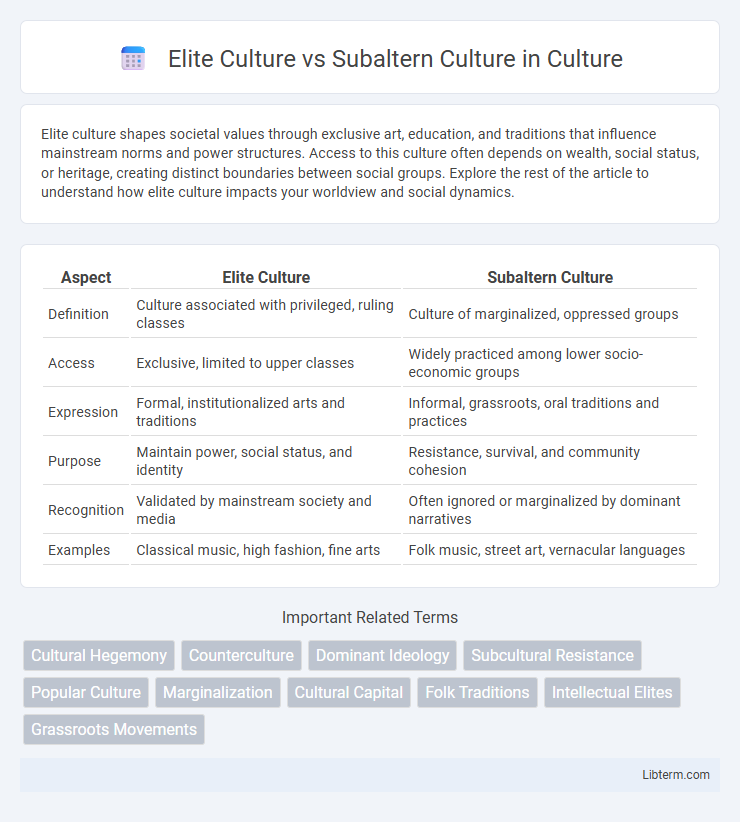Elite culture shapes societal values through exclusive art, education, and traditions that influence mainstream norms and power structures. Access to this culture often depends on wealth, social status, or heritage, creating distinct boundaries between social groups. Explore the rest of the article to understand how elite culture impacts your worldview and social dynamics.
Table of Comparison
| Aspect | Elite Culture | Subaltern Culture |
|---|---|---|
| Definition | Culture associated with privileged, ruling classes | Culture of marginalized, oppressed groups |
| Access | Exclusive, limited to upper classes | Widely practiced among lower socio-economic groups |
| Expression | Formal, institutionalized arts and traditions | Informal, grassroots, oral traditions and practices |
| Purpose | Maintain power, social status, and identity | Resistance, survival, and community cohesion |
| Recognition | Validated by mainstream society and media | Often ignored or marginalized by dominant narratives |
| Examples | Classical music, high fashion, fine arts | Folk music, street art, vernacular languages |
Defining Elite Culture and Subaltern Culture
Elite culture refers to the dominant cultural practices, values, and norms upheld by socially, politically, and economically privileged groups, often associated with institutions of power and high social status. Subaltern culture embodies the lived experiences, traditions, and expressions of marginalized or oppressed communities that resist or exist outside dominant elite narratives. Defining these cultures involves examining power dynamics, access to resources, and the visibility or suppression of cultural expressions within society.
Historical Roots of Cultural Hierarchies
Elite culture often originates from dominant social groups who historically controlled political, economic, and educational institutions, establishing cultural norms that reflect their values and worldviews. Subaltern culture emerges from marginalized or oppressed groups whose traditions and practices resist or exist parallel to dominant narratives, preserving alternative histories and identities. These historical roots create entrenched cultural hierarchies, where elite culture is institutionalized and privileged, while subaltern culture is frequently marginalized or suppressed within mainstream societies.
Power Dynamics Shaping Cultural Narratives
Elite culture exerts influence by controlling dominant narratives and institutional platforms, defining what is considered legitimate knowledge, art, and tradition. Subaltern culture resists by creating alternative narratives that challenge hegemonic power structures, often preserving marginalized identities and histories through grassroots expression. Power dynamics shape cultural narratives by privileging elite perspectives, while subaltern voices negotiate identity and agency within oppressive frameworks.
Expressions and Symbols of Elite Culture
Expressions and symbols of elite culture often embody refined aesthetics, exclusivity, and historical prestige, such as classical art, high fashion, and aristocratic rituals. These cultural markers serve to reinforce social hierarchies and distinguish the elite from subaltern groups. The language, dress codes, and ceremonial practices of elite culture function as symbolic capital that maintains power dynamics within society.
Language and Communication in Subaltern Communities
Subaltern communities use language as a tool of resistance and identity preservation, often developing distinct dialects and vernaculars that challenge elite cultural norms. Communication in these groups emphasizes oral traditions, storytelling, and localized expressions that contrast with standardized, institutionalized language imposed by dominant elites. This linguistic divergence highlights power asymmetries, where elite culture enforces language conformity to maintain control, while subaltern cultures sustain alternative communicative practices to assert autonomy and cultural integrity.
Representation in Media and Literature
Elite culture shapes media and literature through dominant narratives that reflect the values, perspectives, and interests of powerful social groups, often marginalizing subaltern voices. Subaltern culture, represented through alternative media and grassroots literature, challenges hegemonic discourses by highlighting the experiences and struggles of oppressed communities. This ongoing tension influences the visibility and authenticity of diverse identities within cultural production.
Impact of Globalization on Cultural Identities
Globalization accelerates the diffusion of elite culture through international media, commerce, and education, often marginalizing subaltern cultures by overshadowing local traditions and languages. Subaltern cultures face challenges in preserving their unique identities amid homogenizing global influences, sometimes leading to cultural hybridization or resistance movements. The dynamic interaction between elite and subaltern cultures reshapes cultural identities, highlighting power imbalances and prompting debates over cultural preservation and adaptation in a globalized world.
Cultural Appropriation and Misrepresentation
Elite culture often dominates mainstream narratives, leading to the appropriation of subaltern culture's symbols and practices without proper understanding or respect. This process results in the misrepresentation of marginalized communities, distorting their identities to fit commercial or aesthetic purposes. Cultural appropriation in this context perpetuates power imbalances and erases authentic voices from subaltern groups.
Resistance and Revival of Subaltern Traditions
Subaltern culture embodies resistance by preserving indigenous languages, rituals, and oral histories that elite culture often marginalizes or suppresses. Revival efforts include grassroots movements, cultural festivals, and community-led education programs that reclaim identity and challenge hegemonic narratives. This resistance not only asserts the value of subaltern traditions but also fosters social cohesion and political empowerment within oppressed communities.
Towards Cultural Inclusivity and Equity
Elite culture often dominates mainstream narratives, marginalizing subaltern cultures that hold rich, diverse traditions and perspectives. Emphasizing cultural inclusivity requires recognizing and valuing the voices and practices of subaltern groups to dismantle systemic inequities in representation and access. Promoting equity involves creating platforms that elevate marginalized cultures, ensuring their participation in cultural dialogues and decision-making processes.
Elite Culture Infographic

 libterm.com
libterm.com